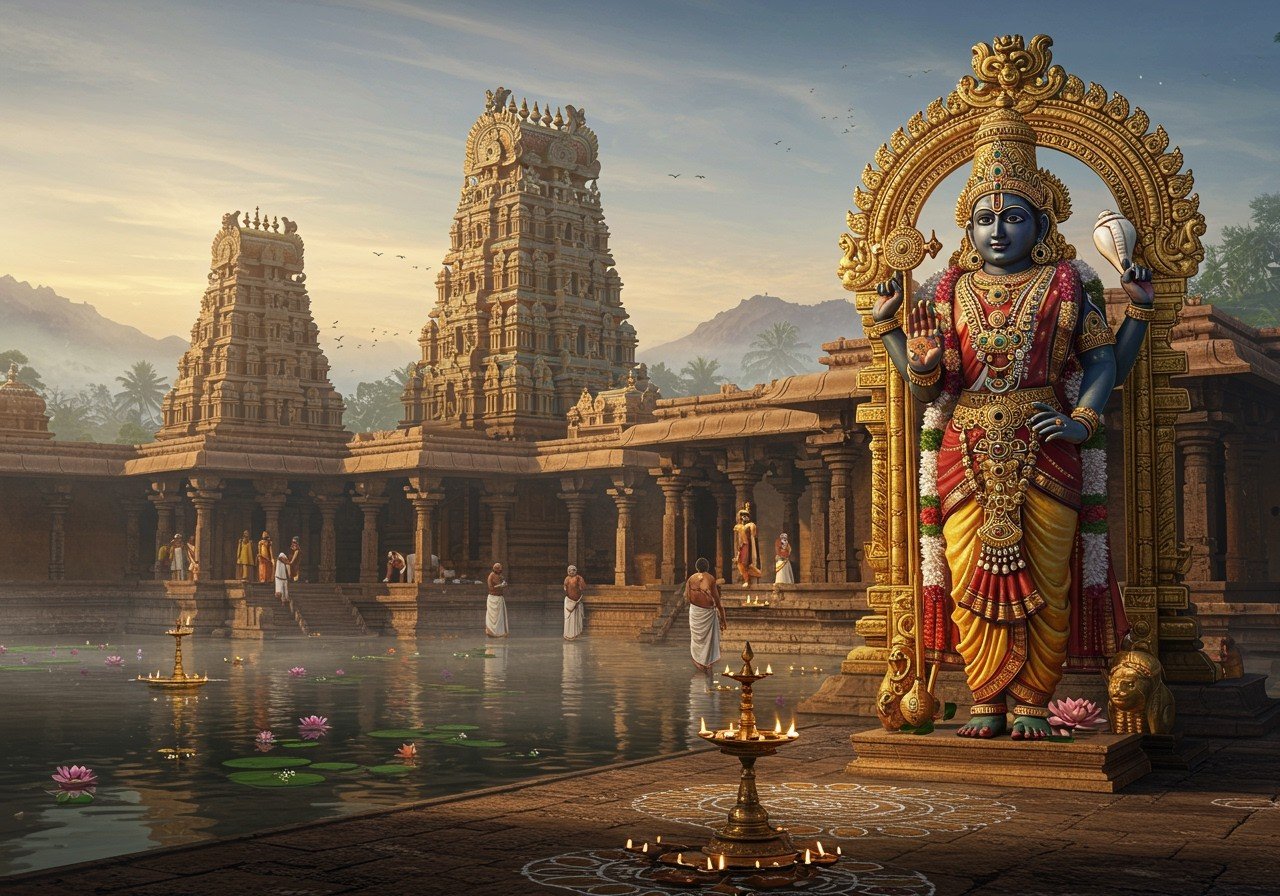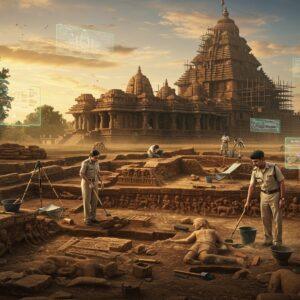
The Azhagiya Manavala Perumal Temple graces the vibrant town of Mannargudi, Tamil Nadu, like a spiritual oasis. Steeped in rich Vaishnavite traditions, this temple holds profound significance for devotees, weaving a captivating narrative of history, devotion, and cultural heritage.
The Spiritual Heart of Mannargudi
At the heart of this sacred space resides Azhagiya Manavala Perumal, the presiding deity, revered as an embodiment of Lord Vishnu. The temple’s Dravidian architecture stands as a testament to the rich spiritual themes it represents. As a beacon of Bhakti traditions, its rituals and ceremonies resonate deeply with devotees, attracting pilgrims and enriching the tapestry of spiritual tourism in South India.
The teachings of Sri Manavala Mamunigal (1370-1443 A.D.), a revered Vaishnava saint and philosopher, add another layer of spiritual depth to this temple. Though not directly dedicated to him, his influence on the Sri Vaishnava tradition is palpable throughout South India, including places like the Azhagiya Manavala Perumal Temple. For those interested in exploring his legacy, temples and centers dedicated to Manavala Mamunigal can be found across the region, including:
- Sri Manavala Mamunigal Kaingarya Sabai, Thiruvallicani, Chennai: This temple houses a striking black granite idol of Sri Manavala Mamunigal, adorned with gold.
- Varadaraja Manavala Mamuni Temple, George Town, Chennai: A unique temple where Manavala Mamuni’s name is linked with the main deity, Varadaraja Perumal.
- Sri Manavala Mamunigal Jeeyar Mutt, Srivilliputtur: Established by the saint himself, this Mutt is a center for Thenkalai Sri Vaishnava tradition and philosophical discourses.
- Tiruvarasu, Srirangam: This is Manavala Mamunigal’s final resting place, located along the Kollidam Flood Bank Road.
- Sri Manavala Mamunigal Sannidhi, Melkote, Karnataka: A dedicated shrine to the saint within the Tirunarayanapuram temple complex.
You can learn more about the divine trinity and the significance of Varaha, Lakshmi, and Narasimha avatars in this insightful blog post: Exploring the Divine Trinity’s Significance.
A Journey Through Time
The Azhagiya Manavala Perumal Temple’s history unfolds across centuries, marked by the contributions of the Chola and Pandya dynasties. Their patronage and renovations have shaped its grandeur. Inscriptions and archaeological findings offer glimpses into its fascinating past, revealing its evolution and resilience through time.
Perumal Temples: Pillars of South Indian Culture
Perumal temples, dedicated to Lord Vishnu, are integral to the cultural fabric of South India. They serve as vibrant hubs for religious, social, and cultural activities. Their architecture echoes the region’s heritage, influencing local traditions, festivals, and daily life. These temples are not just structures of stone; they are living embodiments of Vaishnavite philosophies, enriching the community’s spiritual understanding.
For those fascinated by temple architecture, you might enjoy reading about the Omkareshwar Temple’s design: Omkareshwar Temple Architecture and Design Explained. Or perhaps delve into the history and significance of the Pashupatinath Temple in Mandsaur: Pashupatinath Temple, Mandsaur: A Visitor’s Guide.
Unique Traditions and Local Customs
The Azhagiya Manavala Perumal Temple stands out with its distinctive customs and rituals, meticulously maintained by temple priests. Daily poojas (prayer rituals) deeply involve the community, fostering a sense of shared spirituality. Local festivals celebrated within the temple grounds further strengthen community bonds. Legends and stories, passed down through generations, add a touch of mystique and charm, while also influencing local arts, music, and dance forms.
Festivals: A Celebration of Faith and Culture
Major festivals like Vaikunta Ekadasi and Panguni Uthiram are celebrated with immense fervor at the Azhagiya Manavala Perumal Temple. The entire community participates in elaborate rituals and preparations. Music, dance, and dramatic performances elevate the festive atmosphere, creating a vibrant cultural spectacle that attracts tourists and serves as a powerful expression of tradition.
Poojn.in: Your Companion in Devotion
Poojn.in, India’s leading online store for cultural goods and services, understands the deep significance of these traditions. We offer a wide selection of authentic puja items, carefully curated to help you maintain the sanctity of your home worship. Whether you need temple-quality brass vessels, traditional oil lamps, fragrant sandalwood paste, or pure cotton wicks, we have everything you need to create a sacred space in your home.
Explore our collection of puja essentials, including:
- Brass and Copper Items: From lamps to plates. Discover the beauty and purity of traditional brass and copper puja items, crafted with utmost care and reverence. Explore our brass collection.
- Mala and Garland: For chanting and offerings. Enhance your spiritual practice with our selection of authentic malas and garlands, crafted with natural materials and infused with positive energy. Find your perfect mala.
- Murtis and Deities: Bring divine presence into your home. Browse our exquisite collection of murtis and deities, crafted with intricate details and reverence to inspire your devotion. Find your deity.
We offer convenient doorstep delivery across India, ensuring that your puja items reach you securely and with the utmost respect for their sanctity. For personalized assistance, please feel free to call us at 03369029784 or WhatsApp us at 9476142738. Visit www.poojn.in today and experience the convenience of having authentic puja samagri delivered right to your doorstep.
A Timeless Legacy
The Azhagiya Manavala Perumal Temple stands as more than just a place of worship; it is a living embodiment of South India’s rich spiritual and cultural heritage. Here, tradition and devotion intertwine, offering solace and inspiration to all who seek it. The temple’s timeless rituals and vibrant festivals are a testament to the enduring power of faith and community. It’s a place where the sacred legacy of Azhagiya Manavala Perumal continues to flourish, enriching the lives of devotees for generations to come.
Common Questions About Azhagiya Manavala Perumal Temple
Devotees often wonder about the spiritual significance of Azhagiya Manavala Perumal Temple. This temple holds a special place in the hearts of Vaishnavites as it’s dedicated to Lord Vishnu in his form as “Azhagiya Manavalan,” the beautiful groom. Visiting this temple is believed to bring peace and spiritual upliftment.
Many also ask about the importance of Perumal temples in South India. These temples, dedicated to Lord Vishnu, are deeply woven into the region’s cultural and spiritual landscape. They serve as centers for worship, cultural preservation, and spiritual learning. Their architecture is a testament to South India’s rich heritage.
Curious about the unique customs at Azhagiya Manavala Perumal Temple? One unique tradition involves offering garlands and silk vastram (clothing) to the deity. Devotees also participate in the chanting of ancient hymns, which have been passed down through generations. These are typically Vishnu Sahasranamam, Divya Prabhandham, and other Vedic mantras.
Festivals are a big part of the temple’s life. Devotees often ask which festivals are celebrated here. Vaikunta Ekadasi is the most significant festival, during which devotees observe fasts and offer special prayers to Lord Vishnu. Other important festivals include Panguni Uthiram and the birth anniversary of Manavala Mamunigal.
For those wishing to participate in the rituals, it’s always best to check the temple’s schedule. This will provide information about the timings of daily poojas and special ceremonies, allowing you to fully experience the temple’s spiritual offerings.
Many wonder about the best time to visit. While the temple is open throughout the year, visiting during festivals, especially Vaikunta Ekadasi, provides a unique and vibrant experience. Early mornings and evenings on regular days offer a more peaceful atmosphere for prayer and reflection.
Finally, there are some guidelines for visiting the temple. Dressing modestly is customary, and visitors should remove their footwear before entering. Maintaining silence within the temple premises is encouraged, along with respectful observance of the ongoing rituals and customs. This will help ensure a fulfilling and spiritually enriching visit.


